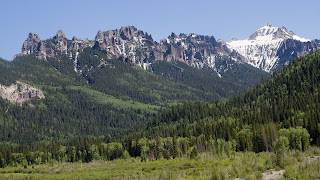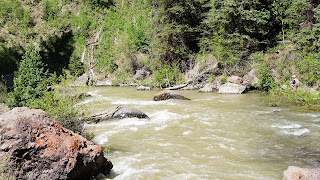I've said before that Montrose is surrounded by mesas and buttes, as well as several mountain ranges. One mesa, in particular, is located right at the western edge of town, in fact stopping the spread of town in that direction. This very large, flat-top mesa is known as Sunset Mesa because it is the highest point in town and a great spot for viewing sunsets. It has some houses, a large and very nice cemetery, several athletic fields and a fair amount of vacant land. I go up there almost every night at the time for sunset and occasionally get some very good ones. This week has had some interesting cloud formations that I think are worth sharing.
When I arrived on Sunset Mesa Monday evening, I immediately noticed massive clouds over the Cimarron Ridge. Those clouds picked up color as the sunset progressed.
From the cemetery, I had a pretty good view of the sun as it went down through a layer of clouds
.
Over Grand Mesa was a layer of nice clouds that picked up reflected light.
On Tuesday, a storm seemed to be brewing as I left my campsite. On Sunset Mesa, I could see very dark clouds to the east and a rainbow forming across the valley. At times, there was a part of a double rainbow, and the clouds became very bright from the setting sun.
Eventually a full arc of rainbow appeared amid the brightly colored clouds. This was unlike any rainbow I had seen before.
Meanwhile, the sunset continued.
I was surprised Wednesday evening by the large lenticular clouds over the mountains. These also picked up red color from the setting sun.
The actual sunset was also pretty good.
From these early experiences, I think I'm going to enjoy watching the Colorado sunsets, and I hope you do, too.



























































